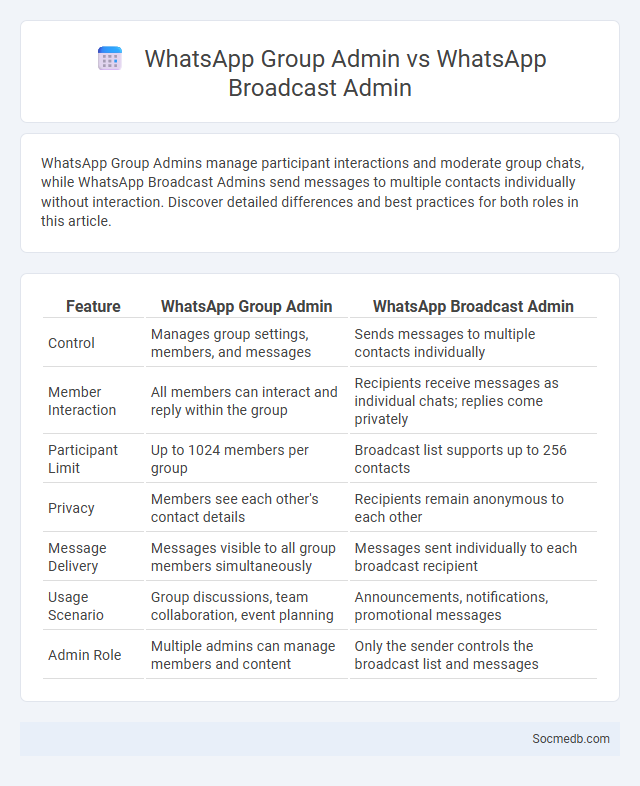
Photo illustration: WhatsApp Group Admin vs WhatsApp Broadcast Admin
WhatsApp Group Admins manage participant interactions and moderate group chats, while WhatsApp Broadcast Admins send messages to multiple contacts individually without interaction. Discover detailed differences and best practices for both roles in this article.
Table of Comparison
| Feature | WhatsApp Group Admin | WhatsApp Broadcast Admin |
|---|---|---|
| Control | Manages group settings, members, and messages | Sends messages to multiple contacts individually |
| Member Interaction | All members can interact and reply within the group | Recipients receive messages as individual chats; replies come privately |
| Participant Limit | Up to 1024 members per group | Broadcast list supports up to 256 contacts |
| Privacy | Members see each other's contact details | Recipients remain anonymous to each other |
| Message Delivery | Messages visible to all group members simultaneously | Messages sent individually to each broadcast recipient |
| Usage Scenario | Group discussions, team collaboration, event planning | Announcements, notifications, promotional messages |
| Admin Role | Multiple admins can manage members and content | Only the sender controls the broadcast list and messages |
Understanding WhatsApp Group Admin Roles
WhatsApp group admins hold key responsibilities such as managing member permissions, controlling group settings, and overseeing content shared within the group. They have exclusive privileges like adding or removing participants and updating group info to maintain order and enforce group rules. Understanding these roles ensures efficient group management and promotes a safe, organized communication environment.
What is a WhatsApp Broadcast Admin?
A WhatsApp Broadcast Admin manages and controls broadcast lists, ensuring messages are sent to multiple contacts without creating group chats. This role involves organizing recipients, maintaining privacy settings, and overseeing message distribution to maximize engagement and avoid spam. Effective WhatsApp Broadcast Admins streamline communication for businesses, events, or communities by delivering targeted updates and announcements directly to individual users.
WhatsApp Group Admin vs Broadcast Admin: Key Differences
WhatsApp Group Admins manage multiple participants, control group settings, and facilitate real-time conversations, while Broadcast Admins send one-way messages to numerous contacts without creating a shared chat space. Your role as a Group Admin includes moderating discussions and adding or removing members, unlike Broadcast Admins who primarily focus on delivering updates efficiently. Understanding these distinctions helps optimize communication strategies on WhatsApp for better engagement and audience management.
Permissions and Privileges: A Comparative Analysis
Understanding permissions and privileges across social media platforms is crucial for securing Your online presence and managing data access effectively. Platforms like Facebook, Instagram, and Twitter offer varying levels of user control, from granular privacy settings to third-party app authorizations, directly impacting Your content visibility and information sharing. Comparing these ecosystems enables You to choose social media channels that best align with Your privacy preferences and digital security requirements.
Adding and Removing Participants: Group vs Broadcast
In social media platforms, adding and removing participants differs significantly between group chats and broadcast messages. Group chats allow dynamic participant management, enabling users to add or remove members who can interact and respond within the chat, fostering collaborative communication. In contrast, broadcast messages send information to multiple recipients without forming a collective conversation, restricting participants to passive receipt without the ability to interact or be removed from the broadcast list by the sender.
Messaging Controls: Group Admin vs Broadcast Admin
Messaging controls differ significantly between group admins and broadcast admins on social media platforms. Group admins manage member interactions by moderating messages, setting permissions, and enforcing rules within the group environment, enhancing community engagement. Broadcast admins, however, send one-way messages to a wide audience without allowing recipients to reply, focusing on direct information dissemination and maintaining message consistency.
Privacy and Security Considerations
Social media platforms collect vast amounts of personal data, making privacy protection a critical concern for users and regulators alike. Implementing robust security measures such as end-to-end encryption, two-factor authentication, and regular vulnerability assessments helps mitigate risks of data breaches and unauthorized access. Users must remain vigilant by customizing privacy settings, avoiding oversharing, and reviewing app permissions to safeguard their digital identities effectively.
Use Cases: When to Choose Each Admin Type
Choosing the right social media admin type depends on your specific needs, such as content creation, account security, or analytics management. For example, a Content Creator admin is ideal when your priority is posting and engaging with followers, while an Analyst admin suits your needs if monitoring performance metrics is crucial. Your team should select admin roles that align with their responsibilities to optimize workflow and protect your social media presence.
Limitations of WhatsApp Group and Broadcast Admins
WhatsApp group and broadcast admins face limitations such as restricted member control, with group admins unable to fully moderate content or prevent spam effectively. Broadcast lists have capped recipients (up to 256 contacts), limiting message reach compared to other platforms. You may find these constraints hinder scalable communication and dynamic engagement in your social media strategy.
Best Practices for Effective WhatsApp Admin Management
Effective WhatsApp admin management requires clear role assignments and consistent communication protocols to ensure smooth group coordination. You should regularly update group guidelines and monitor interactions to maintain a positive, focused environment. Utilizing tools like broadcast lists and automated responses can streamline your administrative tasks and enhance member engagement.
 socmedb.com
socmedb.com